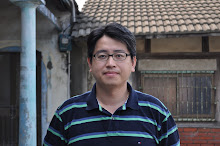Amy and me in Tokyo Japan 2007
Eosinophil-related T helper 2 (Th2) cytokines associated with the protection of coronary artery lesions in Kawasaki disease
Ho-Chang Kuo, MD1,2; Chih-Lu Wang, MD, PhD3; Chi-Di Liang, MD4;
Hong-Ren Yu, MD1,2; Chien-Fu Huang, MD4; Kao-Pin Hwang, MD, PhD5;
Kuender D. Yang, MD, PhD.1,2
Division of Allergy, Immunology and Rheumatology1; Division of Cardiology4 ; and Division of Infectious Disease5, Department of Pediatrics, Chang Gung Memorial Hospital-Kaohsiung Medical Center; Graduate Institute of Clinical Medical Sciences, Chang Gung University College of Medicine, Kaohsiung, Taiwan2; and Department of Pediatrics, Po-Jen Hospital, Kaohsiung, Taiwan.3
ABSTRACT
OBJECTIVE: Kawasaki disease (KD) is a systemic febrile vasculitis especially coronary artery involvement. Eosinophilia has been found in our and other studies in KD. This study further investigates whether eosinophil-related T helper 2 (Th2) cytokines or the activation marker (eosinophil cationic protein, ECP) is involved in KD with coronary artery lesions ( CAL ).
PATIENTS AND METHODS: A total of 95 KD patients were enrolled for this study. Plasma samples were subjected to measurement of interleukin (IL)-4, IL-5 and eotaxin by Luminex-Bedalyte multiplex beadmates system and to measurement of ECP by fluoroimmunoassay. CAL was defined as internal diameter greater than 3 mm of coronary artery.
RESULTS: Patients with KD had higher eosinophils than controls. Eosinophil-related mediators: IL-4, IL-5, eotaxin and ECP levels were also higher in KD patients than controls before intravenous immunoglobulin (IVIG) treatment. After IVIG treatment, ECP decreased but IL-4, IL-5, and eotaxin increased significantly. The higher the IL-5 and eosinophil levels after IVIG treatment, the lower rate of CAL was found. Changes of eosinophils after IVIG treatment were positively correlated to changes of IL-5 levels.
CONCLUSIONS: The Th2 mediator (IL-5) but not ECP levels after IVIG treatment was associated with the protection of CAL formation.
川崎病(川崎氏症)(Kawasaki disease)-是否該用免疫球蛋白(IVIG)來治療?
--Dr.Kuo 與川崎病童的心情故事---
Dr.Kuo 曾遇到一個家屬不肯給川崎病的小朋友接受免疫球蛋白的治療
為什麼?
我也很納悶? 於是我多管閒事的跑去與這位家長溝通
為何是多管閒事ㄋ 因為這位小朋友並不是Dr.Kuo的病人,而是別的主治醫師的病人,依規定不可以執行醫囑或醫療業務
而因為Dr.Kuo在本院主要研究川崎病, 因此就有好心的護理人員會通知我--有川崎病病童住院
經過一陣的內心的掙扎---去或不去----
Dr.Kuo還是決定要去與這位家長溝通,(因為Dr.Kuo不想看到一個川崎病的病童因為錯失治療的黃金時間而產生終生的遺憾--冠狀動脈病變)在經過一個多小時的解釋與溝通 終於 知道 why
--原來這位家屬去問了一位家庭醫師,而這位醫師告訴他不可以打免疫球蛋白否則會產生過敏及改變免疫系統????
根據Dr.Kuo之前於兒科醫學會所發表的論文中有提到:
川崎病目前仍是以發燒十天內給予靜脈注射單次高劑量免疫球蛋白( 2g m/Kg)及合併使用阿斯匹靈為標準的治療方式。
到目前為止尚未有比免疫球蛋白更好的治療方式
全世界都用同樣的治療原則--高劑量免疫球蛋白!
因此Dr.Kuo深深感受---天下父母心---每一個父母都想給小孩最好的,
但在我們替他(她)做決定的同時,是否應該再想一下--------這樣真的是最好的嗎?
Dr.Kuo 曾遇到一個家屬不肯給川崎病的小朋友接受免疫球蛋白的治療
為什麼?
我也很納悶? 於是我多管閒事的跑去與這位家長溝通
為何是多管閒事ㄋ 因為這位小朋友並不是Dr.Kuo的病人,而是別的主治醫師的病人,依規定不可以執行醫囑或醫療業務
而因為Dr.Kuo在本院主要研究川崎病, 因此就有好心的護理人員會通知我--有川崎病病童住院
經過一陣的內心的掙扎---去或不去----
Dr.Kuo還是決定要去與這位家長溝通,(因為Dr.Kuo不想看到一個川崎病的病童因為錯失治療的黃金時間而產生終生的遺憾--冠狀動脈病變)在經過一個多小時的解釋與溝通 終於 知道 why
--原來這位家屬去問了一位家庭醫師,而這位醫師告訴他不可以打免疫球蛋白否則會產生過敏及改變免疫系統????
根據Dr.Kuo之前於兒科醫學會所發表的論文中有提到:
川崎病目前仍是以發燒十天內給予靜脈注射單次高劑量免疫球蛋白( 2g m/Kg)及合併使用阿斯匹靈為標準的治療方式。
到目前為止尚未有比免疫球蛋白更好的治療方式
全世界都用同樣的治療原則--高劑量免疫球蛋白!
因此Dr.Kuo深深感受---天下父母心---每一個父母都想給小孩最好的,
但在我們替他(她)做決定的同時,是否應該再想一下--------這樣真的是最好的嗎?
0
意見
2008年12月8日 星期一


訂閱:
意見 (Atom)



